#Ancient Roman Mosaic Found in Croatia
Text
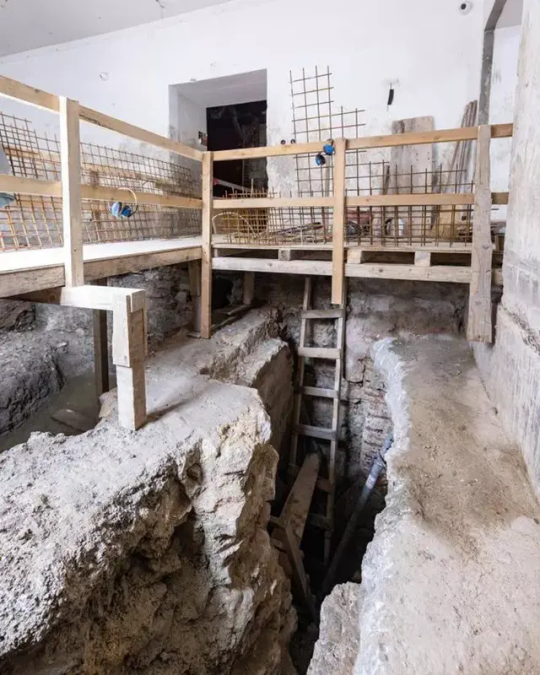

Archaeologists Discovered Large Roman Baths Under Museum in Croatia
The pool, mosaic floors and underfloor heating once formed part of Emperor Diocletian’s palace.
Archaeologists working to install a lift and restore the ground floor of Split City Museum got more than they bargained for when they unearthed sizable Roman baths underneath the building’s reception. The museum in Croatia’s second largest city was founded in 1946 and is held inside the Dominik Papalić palace—the former home of the affluent Papalić family who settled in Split during the 14th century.
The baths are in a well-preserved condition and include a pool, mosaic floors, ancient underfloor heating, an oil and grape press, and a furnace. Communal bathing was common across the Roman Empire, and baths acted as a space for relaxation and socializing.
The Split baths are believed to have been part of Diocletian’s Palace, built in the city at the end of the 3rd century for the Roman emperor’s retirement. The large fortress once spanned half of Split’s Old Town, and parts of the palace’s remains are listed UNESCO World Heritage Sites. The discovery of these Roman baths confute historians’ previous understandings about the layout of the ancient complex.
he repairs were planned as part of the “Palace of Life, City of Change” project, which is described as an “integrated program of development of the visitor infrastructure of the Old City Core with Diocletian’s palace.”


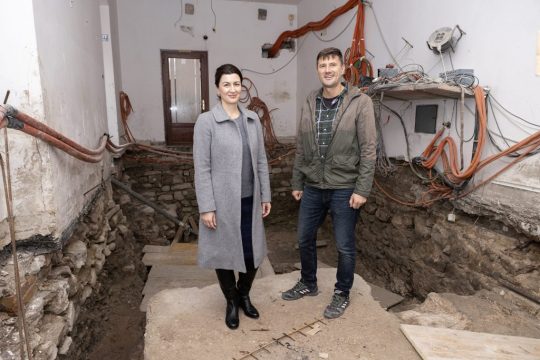
Split lies on the Adriatic Sea coast and was founded in the 3rd century B.C.E. as a Greek colony (then known as Aspálathos). Split’s landscape is made up of myriad architectural styles spanning hundreds of years, from classical ruins to Venetian Gothic structures. The director of the Split City Museum Vesna Bulić Baketić, spoke about the city’s rich architectural composition, “the fact that all of these layers of earlier buildings that once made up the city are visible inside the Split City Museum provides this museum with additional value that is exceptionally rare.”
The museum plans to open up part of the newly discovered baths to the public, once the structural integrity of the building has been ensured. The ground floor will also be restructured to celebrate the new discovery. “Showing our visitors the ‘living past’ that speaks to us through the original layers of centuries long gone adds insurmountable value and legacy to future generations,” Baketić said. “It is up to us to carry this out in the best and most professional way.”
By Verity Babbs.

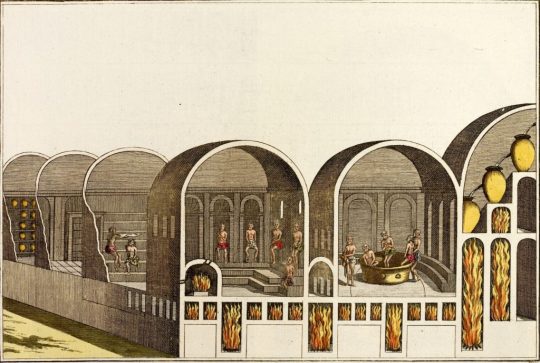


#Emperor Diocletian#Diocletian’s Palace#Archaeologists Discovered Large Roman Baths Under Museum in Croatia#Split Croatia#Split City Museum#roman baths#ancient artifacts#archeology#archeolgst#history#history news#ancient history#ancient culture#ancient civilizations#roman history#roman empire#roman emperor
41 notes
·
View notes
Text
Our Mljet Private And Guided Tours
You are invited to explore Mljet, a stunning island in southern Croatia. If you want to visit the stunning island of Mljet, contact us because we provide both solo and group excursions there. Whether someone wants to explore the lovely national park or discover the fascinating history of the small nearby town, we have something to offer everyone. We cordially invite you to join us on a tour of one of Croatia's most breathtaking islands. Prepare for an unforgettable journey on Mljet, and don't forget to bring your luggage!
Tour of Mljet Island and the National Park
Mljet National Park is regarded as the island's greatest gem, and it is easy to see why. More over a third of Mljet is taken up by the park, which is home to numerous stunning natural landmarks. It feels as though you have entered another universe when you enter this enchanted setting, one with shimmering lakes, luscious forests, and breathtaking shorelines.
The two saltwater lakes in the national park, Veliko Jezero (Big Lake) and Malo Jezero (Small Lake), are visited as part of our guided trip. A narrow canal connects these tranquil bodies of water, which are surrounded by lush flora and provide a picturesque backdrop. You may wander through the islands or take a relaxing boat ride in the clear waters.
Another must-see attraction in Mljet National Park is St. Mary's Island, which is located in the middle of Veliko Jezero. In this spectacular setting, there lies a 12th-century Benedictine abbey. It is definitely worth your time to take a leisurely stroll through its serene grounds and take in the breathtaking views that are all around you.
Take one of the many paths winding through the pristine landscapes of Mljet National Park to explore the park on foot or by bicycle. Nature enthusiasts will have enough to do here, whether they explore on their own or with one of our trained guides.
Check out Mljet Island
Beautiful landscapes and crystal-clear waters may be found on Croatia's Mljet Island. The best way to see everything on the island and learn about its intriguing history is to take a tour.
Odysseus Cave, which bears the name of Homer's mythical hero, is a popular destination in Mljet. To swim in the cool water and see the amazing rock formations, take a boat ride within this underwater cave.
Another must-see location in the park is St. Mary's Island, which is situated in one of the two saltwater lakes in Mljet National Park. On this picturesque island, there lies a 12th-century Benedictine abbey.
Travel to some of the charming communities on the island. Babino Polje is well known for its historic structures, while Saplunara is known for its beautiful beaches.
With a guide, you can unwind and enjoy Mljet's attractions without having to worry about getting lost or missing anything. You may spend more one-on-one time with your tour guide and enjoy a more laid-back environment with your other travelers when you travel in a small group tour mljet.
You'll have a memorable journey exploring Mjlet Island's beauties and learning about its past.
A Tour of Mljet by Foot
Make time to explore the town of Mljet while visiting the gorgeous island of Mljet. The town, which situated on the westernmost point of the island, offers visitors an authentic look at Mediterranean daily life. This charming village will charm you with its narrow lanes and old-world stone residences.
If you're in Mljet Town, Saint Mary's Island should be on your itinerary. On this little but gorgeous island, a 12th-century Benedictine abbey is still standing and in excellent condition. Tourists could take a boat ride to one of the nearby islands to get away from the crowd.
History aficionados can spend countless hours exploring the numerous ancient ruins that dot Mljet Town. One such instance is the Roman Palace, which features exquisite mosaics and lovely architecture.
Make sure to sample some of the local cuisine before leaving Mljet Town, particularly the seafood! Daily seafood deliveries are made, and many restaurants offer traditional Dalmatian dishes like octopus salad and black risotto made with cuttlefish ink.
You can only enjoy Mljet Town's natural beauty and distinctive culture through a guided tour, which will leave you with priceless memories.
Finding the Best Vacation for You With so many options, choosing the right vacation can be challenging. Before choosing to make things simpler, consider these factors.
Set the places and experiences that are most significant to you in order of importance. Do you envision yourself visiting national parks or museums?
Which type of tour do you prefer—public or private?
Decide on a deadline and a fee. Although they may be less expensive than private excursions, group trips with a guide might not fit into your schedule.
Find out all you can about the travel operator. Read the evaluations left by those consumers to confirm they have a high percentage of satisfied clients.
Fourth, find out if the tour includes any of the activities you're interested in, such as hiking or water sports.
Never be afraid to clarify any confusion you may have before you reserve a tour. Finding a reliable source prepared to customize their offerings to meet your unique needs is essential.
This vacation will be even more enjoyable if you select a guided or private tour to Mljet Island that fits your interests, needs, and budget.

1 note
·
View note
Text
The Balkan countries in southeastern Europe are popular places to travel right now. Croatia has long had a reputation for being a top beach destination but now more travelers are waking up to the fact that the whole area has much to offer, from majestic mountains and pristine rivers to old bazaars and impressive archaeological sites. One destination, which is still considered fairly off the beaten track, is Macedonia, a small country with a rich history and beautiful nature. If you’re looking for an interesting Balkan destination with fewer tourists, Macedonia makes a great choice. Here are the top five places to visit in Macedonia.
Skopje
The capital of Macedonia, Skopje has a lot to offer foreign visitors. In 2014, the city went through a huge renovation, involving the construction and reconstruction of bridges, museums, government buildings, and monuments of famous Macedonian historical figures. Probably the most famous of these monuments is the Warrior on a Horse statue and fountain in Macedonia Square, which is famed for its ivory reliefs and bronze figures. The statue is believed to be Alexander the Great, although this has never been officially confirmed. Other monuments to check out include: Mother Teresa, who was a Skopje native; Porta Macedonia, a triumphal arch commemorating Macedonian Independence; and the Warrior Monument, thought to depict Philip II of Macedon.
This slideshow requires JavaScript.
Across the river from Macedonia Square, you will find the Old Bazaar, one of the largest in the Balkans and where traders have been hawking their wares since the 12th century. As well as being a great place to pick up bargains, the bazaar also has cultural and historical significance. Ottoman and Byzantine architecture are both present and there are several active mosques and churches in the area.
Other points of interest in Skopje include: Kale Fortress, sitting on the highest hill in the city and offering great views; the Aqueduct, probably built during Byzantine times and still with 55 arches standing; and City Park, which has an array of monuments and places of interest, including the zoo and a children’s amusement park. Skopje is also well known for its cafe culture; pretty much every street has several cafes with excellent and cheap coffee and tea.
Archeological museum of Skopje
Ohrid
Set against the background of Lake Ohrid and often called the ‘Jewel in Macedonia’s crown’, the town of Ohrid is known as the spiritual heart of Macedonia because of its 365 churches – one for every day of the year. As well as having important historical significance as one of the oldest human settlements in Europe, it is also an area of outstanding beauty. The town was designated a UNESCO heritage site in 1980.
The lake itself is more three million years old and contains over 1,200 species of plants and animals 200 of which do not exist anywhere else on the planet. New species continue to be discovered. Because of this, the lake has been referred to as the Balkan Galapagos and the Museum of Living Fossils. There are plenty of beaches around the lake to enjoy; as a general rule, the further out of the town you go, the better the beach.
Ohrid is a town full of churches, but there are some of particular importance that you shouldn’t miss. Possibly the most impressive is the Church of St John at Kaneo, most notable for its scenic location on a cliff overlooking Kaneo Beach and also for the beautiful frescos in the dome. The church itself dates back to before the rise of the Ottoman Empire in the 13th century and there is evidence of Armenian influence in the architecture, particularly in the roof design. Other churches of significance are: St Bogorodica Prelivlepta, with a number of interesting frescos throughout the building; and the Church of St Sophia, which dates back to the 11th century in its current construction. It has a small square in front that served as the main forum in ancient times.
Other things to see in Ohrid are: the fortifications, parts of which have survived from the 3rd century BC; the traditional architecture of the houses and other buildings, built by the Turks who settled in the town and which are unique to Ohrid; and the Antique Theater, the only one existing from Hellenistic times in Macedonia.
This slideshow requires JavaScript.
Bitola
Bitola is known in the country as being the most architecturally beautiful of all Macedonian towns and cities. The town has a more European feel than others in the country owing to Bitola being a seat of consuls during the 19th century. They brought European culture with them, in turn influencing the local aristocracy, who built townhouses in the style of the day, Neoclassicism. It also serves as the jumping off point for Pelister National Park, located in the Baba Mountain massif and one of the most southern Balkan mountain areas, which has an alpine character. As well as being a popular skiing resort, the park is home to an incredibly diverse range of flora and fauna.
Bitola is also the site of Heraclea, an ancient Greek city founded by Philip II of Macedon and later ruled by the Romans. Only a few of the remains have been unearthed; you can see a theater, a courthouse, two basilicas, and baths. The main draws of the site are the mosaics of the big basilica from the 5th century.
The old bazaar may not be as large as the one in Skopje, but it is very well-kept and has numerous small squares and fountains, making for a pleasant shopping experience. A stroll down the Dragor River with its many attractive buildings, such as the Bitola University Dean’s building, is also worthwhile.
Prilep
Prilep has a rather strange claim to fame; it is known for being the city of the most famous Macedonian tobacco. All around the city are tobacco fields and if you visit during the summer or fall, you will be able to see the tobacco drying out everywhere. Prilep was the capital of the medieval kingdom of King Vukasin and his son Marko in the 14th century who have both been immortalized in Macedonian and Serbian folk legends as the monarchs who kept out the Turks; when Marko died, the Turks invaded and took control of the area. Due to its history as a medieval capital, the city is home to a number of churches and monasteries as well as the fortress that stands on the hill overlooking the city.
Prilep
Kruševo
As the center of the Vlach minority, a Romance ethnic group native to the Balkans, Kruševo is notable for its unique architecture. Vlach housing is built of stone in the back and has a front ‘bondruk’ construction of wooden columns and beams covered with white plaster. There is almost always a well in the ground floor and the main facade is usually blue. It is also known as one of the centers of the Ilinden Uprising at the beginning of the 20th century, a rebellion against the Ottoman Empire. A museum exists in the town, which gives information on this important event in the country’s history. Aside from the architecture, another point of interest is the Nikola Martinovski gallery; Martinovski was a local-born artist and is considered one of the most important contemporary Macedonian painters. The gallery is located in the house where the artist was born.
Visitor numbers don’t reflect whether you should visit Macedonia or not. If you are interested in history and culture, Macedonia makes the perfect destination.
This monument is the symbol of Kruševo and of the Ilinden Uprising in 1903 against the Ottoman Empire.
Macedonia: Five Places to Visit The Balkan countries in southeastern Europe are popular places to travel right now. Croatia has long had a reputation for being a top beach destination but now more travelers are waking up to the fact that the whole area has much to offer, from majestic mountains and pristine rivers to old bazaars and impressive archaeological sites.
0 notes
Photo
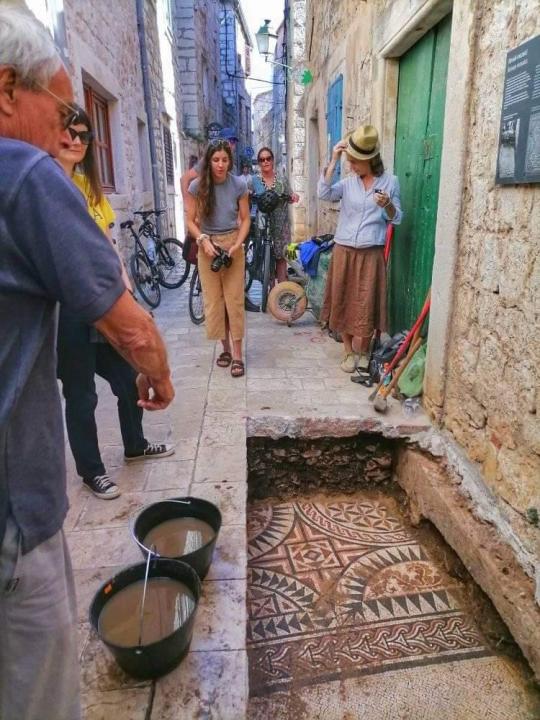
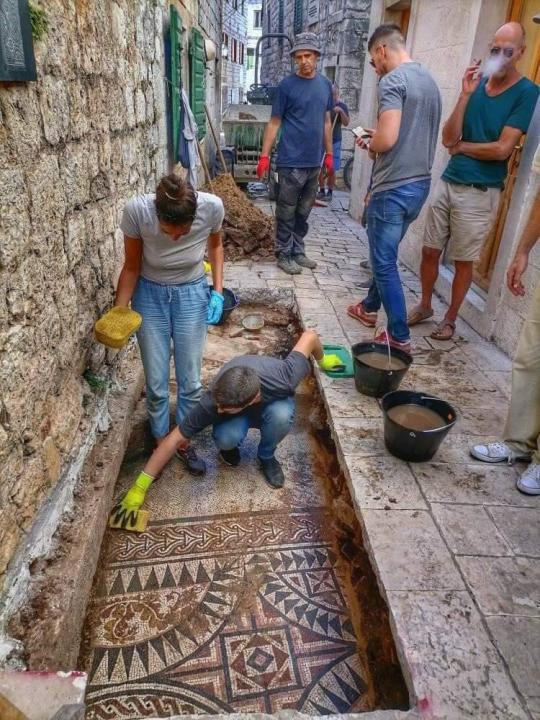
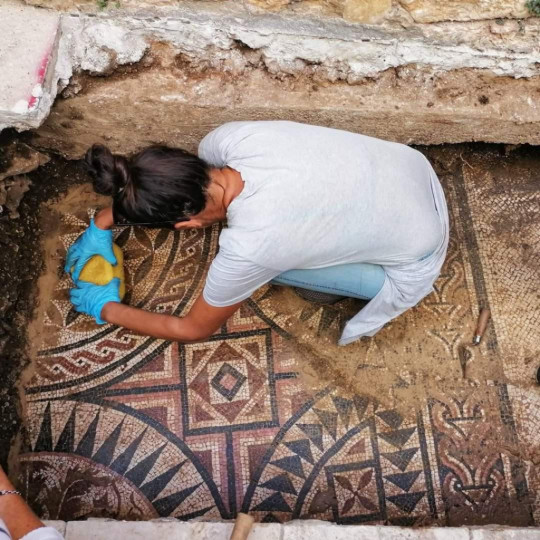
Ancient Roman Mosaic Found in Croatia
A Roman mosaic has been revealed under a narrow street in the Old Town of the Adriatic island of Hvar, Croatia. The elaborate geometric mosaic floor dates to the 2nd century A.D. and was part of a luxurious Roman villa urbana.
The street is being excavated prior to water and sewage work, but this is the second bite at the apple. In 1923, the site was opened to build a canal for rainwater drainage and the remains of the villa were discovered two feet below street level. The finds were eventually covered with slabs and reburied to protect them from water penetration.
The installation of the water drainage system was not completed after the 1923 excavation and increasing problems with penetration from ambient moisture and rising sea levels threaten the survival of the ancient remains of Roman Pharia in Hvar’s historic Old Town. Residents would like to see the mosaic remain in situ, covered with plexiglass so it can be protected and enjoyed at the same time, but the sea has risen by a foot and a half since the mosaic was created and the street is no longer dry land. The new water pipe installation is still happening too, and they will be just a few inches above the mosaic.
Archaeologists are currently excavating 14 other spots next to the mosaic site, looking for other remains from the villa urbana, other mosaics and any archaeological evidence that might identify the structure, or at least define it as a public or private building. When excavations are complete, officials will have a better idea of what steps to take next.
Right now the plan proposed by the archaeologists of the Museum of the Old Town is to raise the mosaic and transport it to the museum for long-term conservation and eventual display. They’ll replace it with a replica that can be walked on without damage. That proposed solution has to be approved by conservators and heritage officials from Split.
#Ancient Roman Mosaic Found in Croatia#ancient artifacts#archeology#archeolgst#history#history news#ancient history#ancient culture#ancient civilizations#roman culture#roman empire#art#artist#art work#art news#ancient art
1K notes
·
View notes
Photo





1800-Year-Old Roman Statue Fragment Discovered in Croatia
January 15, 2022 - A Roman goddess Venus statue in Zadar has been discovered at the construction site of a future hotel. It is about 1800 years old.
A statue of the Roman goddess Venus was found on the construction site of a future hotel in the center of Zadar, about a meter high, preserved from the knees to below the chest, made of marble, and about 1800 years old, reports Slobodna Dalmacija.
"Academician Nenad Cambi, our greatest expert on antiquity, believes that it is most likely a statue of the goddess Venus. Its full height was about two meters, and it was probably on a pedestal in the atrium of this ancient urban villa where we are now," said Smiljan Gluščević.
A statue of the Roman goddess of beauty, love, fertility, and sexuality was found at a depth of about two meters, and stone fragments of a large base, most likely a crown, were discovered in the immediate vicinity.
"Such examples of ancient plastic are very rare in our country. However, a similar remnant of a statue of Venus exists in the Archaeological Museum in Split," said academician Cambi, and Gluščević added:
"We found a precious and rare statue, which will be known more after its cleaning and conservation."
As soon as Venus was taken out of the earth, it was clear to archaeologists that they had discovered a "sensation." It was immediately separated from other artifacts and transferred to the depot of the Homeland Museum in Biograd na Moru. An agreement was signed on the disposal of all finds at the investigation site.
Smiljan Gluščević points out that the statue is attractive and has several details.
"On the left leg is a broken part of someone's hand, on the right thigh as if it were someone's fingerprints. Some "prints" can also be seen near the groin and on the part of the body below the chest ... Archaeological analysis should explain these things. Academician Cambi believes that part of the hand on the left leg most likely belongs to the god Mercury, with whom Venus is often iconographically associated.
These are all, I emphasize, preliminary knowledge, but it is undoubtedly a special find and statue that would be nice to present in a new building," said Gluščević, who also interpreted the archaeological context in which Venus was found.
"It was, therefore, most likely one of the sculptures from the atrium of this ancient urban villa. A marble floor of about 80 square meters was also found where the statue was discovered.
t extends to the east, south, and north, so we don't know the true dimensions of that central part of the villa. But considering other finds - an 11-meter-long canal for sewage, the remains of an ancient wall lined with gray marble tiles, and the remains of a black-and-white mosaic covering an area of some four square meters - we can say that it is a rich urban villa between the second and fourth centuries, which very likely had a floor."
The location of the villa and the details of the mosaic coincided with the results of research by Professor Boris Ilakovac 60 years ago. Before constructing the neighboring building of Božidar Rašica, he researched the foundations of buildings demolished during and after the Second World War.
Professor Ilakovac found two villas in a row there; they touched each other's outer walls and had an identical mosaic decoration in the atrium. All this tells us that here, a hundred meters from the ancient Forum, several representative residential buildings were later, possibly in the early Middle Ages, demolished and only now being revealed in their full beauty.
We have also discovered several medieval walls, but it is too early to talk about their interpretation. Nevertheless, this is proof of the continuity of urban life on the Zadar Peninsula. Apparently, these villas were located within the ancient insula, possibly created before Christ, and divided by cards and decums where today's streets in this part of the city pass, with an average size of 40 by 20 meters," explains Gluščević.
Other interesting inventions are fragments of ancient and Byzantine pottery that probably arrived there between the fourth and sixth centuries. Fragments of luxury tableware from North Africa that do not belong to the time before the third century have also been found, and some could be dated to the fourth and fifth centuries, respectively.
If the owners get permits, and if they wish, these artifacts could be found in the window of the future hotel.
"It is difficult to talk about it because it does not depend on me but the conservators and investors of this facility. But, as an archaeologist, I would love to see a hotel display case with findings, to see the genius loci, the historical stratification of the place, and I think that would be attractive to visitors.
In addition, I believe that the found remains of the mosaic could be taken out and presented somewhere because today there is a developed technique for such a thing," he emphasized.
By Daniela Rogulj.
#art#artist#art work#art news#ancient statue#ancient artifacts#archeology#archeolgst#history#history news#ancient history#ancient culture#ancient civilizations#1800-Year-Old Roman Statue Fragment Discovered in Croatia#roman goddess venus
16 notes
·
View notes